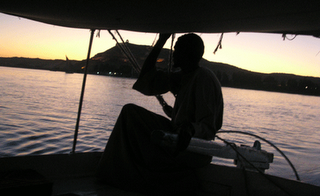Intended Consequences, Aswan
 The high dam at Aswan may be the most visible of the Cold War monuments. It certainly had as direct and violent an impact on as many lives as any other aspect of the Soviet-American competition.
The high dam at Aswan may be the most visible of the Cold War monuments. It certainly had as direct and violent an impact on as many lives as any other aspect of the Soviet-American competition.
There it is, stretching in front of us in a great curve, 3,600 meters long, arcing into the distance, gathering the Nile behind its walls into a huge reservoir that stretches south through the desert to cross into what was once part of Sudan. Aswan is a colossus, bigger even than any imagination can stretch. By comparison the spillway seems miniscule, water sliding over its face in millions of gallons reduced to the apparent size of a trickle by the awe-inspiring immensity of the dam, itself.
“Everyone who lives in Aswan,” our guide says, “is proud of the dam. Everyone here has a relative who worked on it. This is our dam.”
I don’t like the dam, but I understand. Anyone who grows up in the shadow of one of these mighty constructions would. A dam is an easy thing to admire, to take pride in.
“Aswan controls the floods and provides electricity for all of Egypt,” Osama says. “It stores so much water that we could withstand long times without rain.” Later, he admits, “Of course, there are some problems.”
Like it dispossessed some hundred thousand people of their lands, homes, and towns, directly killing 451.
Like it flooded dozens of priceless historical landmarks.
Like it cost the international community millions to move the most valuable of the temples.
Like it flooded the rest.
Like it opened up new farmland but stopped the annual flows of silt onto the Nile delta, leaving once excessively fertile land fertilizer dependent. Visibly, across the country salts are rising, requiring new and expensive land treatments—that’s for the ground not being taken over by apartment blocks.
Like the reservoir is silting up and continuing to spread.
Like the ever full canals propagate bilharzias, causing a public health crisis.
Most of these consequences were anticipated. In the early 1950’s the United States refused funding for the project because of them, suggesting a series of smaller dams. I’m old enough to remember this and Egypt’s reaction, which was to nationalize the Suez Canal, thereby sparking a brief war during which we sided with Egypt and against England and France (we still did things like that, then).
When the dust settled, and Washington stood firm against the monstrous dam (still the world’s largest as of this writing), the Soviets grinned and opened their money chests.
We walk out along the dam’s top, going as far as a military barrier that blocks the roadway, the wind ruffling our hair, seagulls flying. Water bracketed by sand reaches to the horizon.
“It’s a sensitive military zone,” our guide says, and I have no doubt but that he’s right. If the dam hadn’t still been under construction during the Six Day War, one could assume it would no longer still stand.
We don’t stop at a tall monument, “Built to celebrate Soviet-Egypt friendship,” our guide says. “Now … ?” He gives a small laugh, it’s a rueful sound containing a world of questions and change. The Soviet Union no longer exists. The cold war is over. The great Egyptian ally is again America.
Another complexity edges into his voice. The Egyptians don’t like America much. Our guide doesn’t, either. “We know that our President is forced to do things. We understand,” he says on another occasion, meaning that Mubarek’s policies are jammed down his throat by Washington. “Now …?” with a laugh. Much meaning is wrapped up in that one small sound; that one small word.
Here are some unintended consequences to mix with the intended ones.

0 Comments:
Post a Comment
<< Home